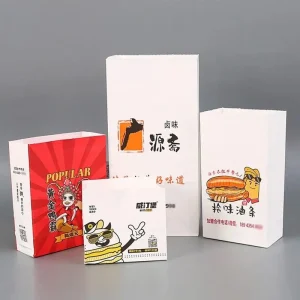Why Bag Decomposition Matters
Using a paper bag seems simple. But what happens after disposal? Knowing how long a paper bag takes to decompose helps us measure its environmental impact. Especially for paper packaging for food, which often gets tossed soon after use, decomposition speed is key. This article explores decomposition times, influencing factors, comparisons to other materials, and real world data.
What Does “Decompose” Mean?
Decompose means breaking down into simpler substances by microorganisms, Độ ẩm, oxygen, and heat. Organic material returns to soil, Nước, and air. Not all conditions allow full decomposition. In landfills, lack of oxygen slows decay.
Typical Decomposition Times for Paper Bag
Under favorable conditions—moist, warm, and with microbes—a plain, uncoated paper bag may degrade in two to six weeks. In less ideal settings, such as mixed waste heaps or dry zones, it can take two to five months. Some thick or coated bags may last even longer depending on material type and environment.

In brief:
- Best case: a few weeks
- Moderate case: one to three months
- Worst case: several months or more
Bàn: Decomposition Time Ranges
| Condition | Decomposition Time | Ghi chú |
|---|---|---|
| Compost heap, moist | 2–6 weeks | Ideal case |
| Garden soil, moderate | 4–12 weeks | Good microbial action |
| Landfill, low oxygen | 2–5 months (or more) | Slower due to lack of air |
| Coated or waxed bags | Several months to years | Additives slow down decay |
Factors That Slow or Speed Decay
Moisture and Humidity
Water accelerates microbial activity. A dry environment hinders microbes. When a paper bag stays dry, it can last much longer.
Oxygen and Aeration
Air is essential. Decomposition is aerobic. In sealed landfill zones, oxygen is scarce and decay stalls.
Microbial Presence
Fungi and bacteria break cellulose down. If soil lacks microorganisms, decay is slow.
Bag Composition and Coatings
If a bag has plastic linings, wax, or heavy inks, decomposition slows greatly. Pure paper breaks down faster.
Thickness and Density
Thicker bags or multiwall designs resist decay. More layers mean more time for microbes to penetrate.
Temperature and Sunlight
Warm conditions speed breakdown. Sunlight can help decaying exposed bags. Cold slows the process.
Bàn: Key Influencing Factors
| Factor | Effect | Example |
|---|---|---|
| Moisture | Speeds decay | Wet, compost pile |
| Oxygen | Speeds decay | Aerated pile |
| Coatings | Slows decay | Wax, plastic lamination |
| Thickness | Slows decay | Multiwall or reinforced bags |
Comparisons: Paper vs Plastic and Other Materials
Paper decomposes far faster than plastic. A plastic bag may last for centuries, while a paper bag can vanish within weeks or months. Tuy nhiên, even paper in a landfill may not fully degrade quickly because buried layers lack oxygen and moisture.
So while paper is better for the environment, proper disposal and composting are still essential to ensure real sustainability.
Paper Packaging for Food: Special Considerations
When paper bags are used for food packaging, they often include coatings, grease resistance, or barrier layers. These additives can slow decomposition. Such barriers reduce moisture penetration and microbial activity, extending life beyond normal paper bags.

Cũng, food residue may feed microbes but can promote mold or odor. Tổng thể, paper packaging for food tends to decompose slower than uncoated paper due to protective treatments.
Bàn: Decomposition in Food Packaging Use
| Type of Paper Bag | Likely Decomposition Time | Reason |
|---|---|---|
| Plain kraft paper | 2–6 weeks (ideal) | No coatings, easy microbial access |
| Grease-resistant paper | 1–3 months | Coating slows moisture and microbes |
| Laminated or plastic-lined bag | Several months to years | Embedded film resists breakdown |
Why Decay May Stall
- Bags buried deep with little airflow
- Low moisture content
- Lack of microbial life
- Use of coatings or inks
- Thick or dense structure
Under such conditions, a bag may persist for a year or more with minimal visual change.
Environmental Impacts of Decomposing Paper
When biodegradable materials decompose without oxygen, they can release methane, a greenhouse gas. Proper composting with air is preferable. Recycling paper reduces waste and forest use, offering a better sustainability cycle.
How to Improve Decomposition
You can help paper bags decompose faster by:
- Cutting or shredding before disposal
- Keeping them moist
- Mixing them into compost
- Ensuring air flow
- Avoiding coated or laminated paper
These steps help microbes work efficiently and return the bag to nature faster.
The Lifecycle View
We should not judge a bag only by how fast it disappears. Its entire lifecycle—from raw material, production, usage, to disposal—defines its true environmental value. Sustainable sourcing and recycling matter as much as decomposition time.
Bản tóm tắt
A paper bag’s decomposition time ranges from a few weeks to several months. Coatings, thickness, burial depth, and environmental factors affect the rate. Paper packaging for food may take longer due to grease-resistant layers. While paper decays far faster than plastic, composting or recycling helps ensure its return to the ecosystem without harm. By choosing simple, recyclable paper bags and managing waste correctly, we can make packaging truly sustainable.
